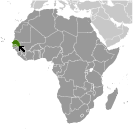World Atlas: Senegal. On this page you can see the map, country flag and many detailed information about the people, history and economy of Senegal.

Here you can find online selected information about the geography, inhabitants, government, economy and history of Senegal. Included are selected statistics, an overview map and the detailed map of Senegal. But let's start with the flag of Senegal here:
Senegal - Overview:
What you should know about Senegal? Let's start with this: The French colonies of Senegal and French Sudan were merged in 1959 and granted independence in 1960 as the Mali Federation. The union broke up after only a few months. Senegal joined with The Gambia to form the nominal confederation of Senegambia in 1982. The envisaged integration of the two countries was never implemented, and the union was dissolved in 1989. The Movement of Democratic Forces in the Casamance has led a low-level separatist insurgency in southern Senegal since the 1980s. Several peace deals have failed to resolve the conflict, but an unofficial cease-fire has remained largely in effect since 2012. Senegal remains one of the most stable democracies in Africa and has a long history of participating in international peacekeeping and regional mediation. Senegal was ruled by a Socialist Party for 40 years until Abdoulaye WADE was elected president in 2000. He was reelected in 2007 and during his two terms amended Senegal's constitution over a dozen times to increase executive power and weaken the opposition. His decision to run for a third presidential term sparked a large public backlash that led to his defeat in a March 2012 runoff with Macky SALL, whose term runs until 2019. A 2016 constitutional referendum reduced the term to five years with a maximum of two consecutive terms for future presidents.
Geography of Senegal
 Where on the globe is Senegal? The location of this country is Western Africa, bordering the North Atlantic Ocean, between Guinea-Bissau and Mauritania. Total area of Senegal is 196,722 sq km, of which 192,530 sq km is land. So this is not a large country. How could we describe the terrain of the country? This way: generally low, rolling, plains rising to foothills in southeast. The lowest point of Senegal is Atlantic Ocean 0 m, the highest point unnamed elevation 2.8 km southeast of Nepen Diaka 648 m. And the climate is tropical; hot, humid; rainy season (May to November) has strong southeast winds; dry season (December to April) dominated by hot, dry, harmattan wind.
Where on the globe is Senegal? The location of this country is Western Africa, bordering the North Atlantic Ocean, between Guinea-Bissau and Mauritania. Total area of Senegal is 196,722 sq km, of which 192,530 sq km is land. So this is not a large country. How could we describe the terrain of the country? This way: generally low, rolling, plains rising to foothills in southeast. The lowest point of Senegal is Atlantic Ocean 0 m, the highest point unnamed elevation 2.8 km southeast of Nepen Diaka 648 m. And the climate is tropical; hot, humid; rainy season (May to November) has strong southeast winds; dry season (December to April) dominated by hot, dry, harmattan wind.
Inhabitants of Senegal
Let's take a look how many people live in Senegal. The number is: 14,668,522 (July 2017 est.). So this is not very populous country. Who lives here? Wolof 38.6%, Pular 26.6%, Serer 14.9%, Mandinka 4.6%, Jola 4.1%, Soninke 2.3%, other 8.9% (includes Europeans and persons of Lebanese descent) (2010-11 est.). What are the languages in Senegal? French (official), Wolof, Pular, Jola, Mandinka, Serer, Soninke. And the religions: Muslim 95.3% (most adhere to one of the four main Sufi brotherhoods), Christian 4.3% (mostly Roman Catholic), animist 0.4% (2010-11 est.). How old are the people in average? 18.8 years. We have to add that this number is the median - so one half of the people is older than this, one half is younger. And what is their life expectancy (at birth)? This: 62.1 years. Where the people live in Senegal? Here: the population is concentrated in the west, with Dakar anchoring a well-defined core area; approximately 70% of the population is rural. The major urban areas of Senegal are: Dakar (capital) 3.52 million (2015).
Government and Economy of Senegal
The capital of Senegal is Daka and the government type presidential republic. Let's take a look at the administrative divisions - 14 regions (regions, singular - region); Dakar, Diourbel, Fatick, Kaffrine, Kaolack, Kedougou, Kolda, Louga, Matam, Saint-Louis, Sedhiou, Tambacounda, Thies, Ziguincho. Regarding the economy of Senegal, important industrial products are agricultural and fish processing, phosphate mining, fertilizer production, petroleum refining, zircon, and gold mining, construction materials, ship construction and repai. Important agricultural products are peanuts, millet, corn, sorghum, rice, cotton, tomatoes, green vegetables; cattle, poultry, pigs; fish. The most important export commodities are fish, groundnuts (peanuts), petroleum products, phosphates, cotton and the most important export partners are Mali 18.2%, Switzerland 10.6%, India 8.2%, Cote dIvoire 5.3%, China 5% (2016). The most important import commodities are food and beverages, capital goods, fuels and the most important import partners are France 15.9%, China 10.3%, Nigeria 7.8%, India 7.6%, Netherlands 5.3%, Spain 4.9% (2016). How rich is Senegal and how rich are people in this country? The most important number here is GDP per capita (PPP): $2,700 (2017 est.). This is a very low number. Let's add that this means Gross Domestic Product per person, which is recalculated with respect to the relative cost of local goods and services. And one more important number - population below poverty line: 46.7% (2011 est.).